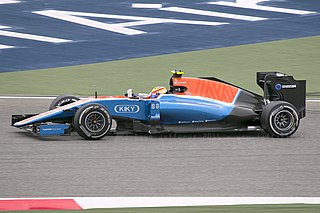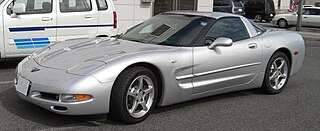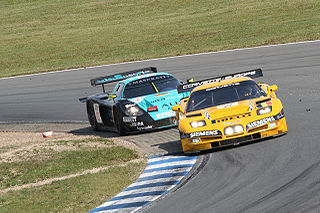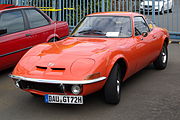
Lotus Group is a British multinational automotive manufacturer of luxury sports cars and electric lifestyle vehicles.

The Lotus Elite name has been used for two production vehicles and one concept vehicle developed and manufactured by British automobile manufacturer Lotus Cars. The first generation Elite Type 14 was produced from 1957 until 1963 and the second generation model from 1974 until 1982. The Elite name was also applied to a concept vehicle unveiled in 2010.

The Chevrolet Corvette is a line of American two-door, two-seater luxury sports cars, manufactured and marketed by GM, under the Chevrolet marque, since 1953.

Cord was a brand of American luxury automobile manufactured by the Auburn Automobile Company of Connersville, Indiana, from 1929 to 1932 and again in 1936 and 1937.

A headlamp is a lamp attached to the front of a vehicle to illuminate the road ahead. Headlamps are also often called headlights, but in the most precise usage, headlamp is the term for the device itself and headlight is the term for the beam of light produced and distributed by the device.

The Lotus Esprit is a sports car built by Lotus Cars from 1976 to 2004 at their Hethel, England factory. It has a rear mid-engine, rear-wheel-drive layout. Together with the Lotus Elise / Exige, it is one of Lotus' most long-lived models.

The Opel Omega is an executive car engineered and manufactured by German automaker Opel between 1986 and 2004. The first generation, the Omega A (1986–1994), superseded the Opel Rekord. It was voted European Car of the Year for 1987, and was available as a saloon or estate. The second generation, the Omega B, was manufactured from 1994 to 2004.

The Buick Skyhawk is an automobile produced by Buick in two generations for the 1975 through 1989 model years.

A transaxle is a single mechanical device which combines the functions of an automobile's transmission, axle, and differential into one integrated assembly. It can be produced in both manual and automatic versions.

In automotive engineering, a mid-engine layout describes the placement of an automobile engine in front of the rear-wheel axles, but behind the front axle.

The Chevrolet Corvette (C6) is the sixth generation of the Corvette sports car that was produced by Chevrolet division of General Motors for the 2005 to 2013 model years. It is the first Corvette with exposed headlamps since the 1962 model. Production variants include the Z06, ZR1, Grand Sport, and 427 Convertible. Racing variants include the C6.R, an American Le Mans Series GT1 championship and 24 Hours of Le Mans GTE-Pro winner.

The Chevrolet Corvette (C5) is the fifth generation of the Corvette sports car, produced by the Chevrolet division of General Motors for the 1997 through 2004 model years. Production variants include the high performance Z06. Racing variants include the C5-R, a 24 Hours of Daytona and 24 Hours of Le Mans GTS/GT1 winner. The C5 Corvette was the first GM vehicle to feature the third generation small block "LS" engines. Pop-up headlights were featured on a Corvette for the final time during this generation.

The Chevrolet Corvette (C4) is the fourth generation of the Corvette sports car, produced by American automobile manufacturer Chevrolet from 1983 until 1996. The convertible returned, as did higher performance engines, exemplified by the 375 hp (280 kW) LT5 found in the ZR-1. In early March 1990, the ZR-1 would set a new record for the highest 24 hour-5,000 mile land-speed by going over a speed of 175 mph (282 km/h). With a completely new chassis, modern sleeker styling, and other improvements to the model, prices rose and sales declined. The last C4 was produced on June 20, 1996.
MagneRide is an automotive adaptive suspension with magnetorheological damper system developed by the Delphi Automotive corporation, during a period when the company was a subsidiary of General Motors (GM), that uses magnetically controlled dampers, or shock absorbers, for a highly adaptive ride. As opposed to traditional suspension systems, MagneRide has no mechanical valves or even small moving parts that can wear out. This system consists of four monotube dampers, one on each corner of the vehicle, a sensor set, and an ECU to maintain the system.

The Chevrolet Corvette C5-R is a grand touring racing car built by Pratt Miller and Chevrolet for competition in endurance racing. The car is based on the C5 generation of the Chevrolet Corvette sports car, yet is designed purely for motorsports use. It became one of the most successful cars in GT categories, with wins at the 24 Hours of Daytona, 12 Hours of Sebring, and 24 Hours of Le Mans, as well as championships in the American Le Mans Series. The Corvette C5-Rs debuted in 1999 and continues to be raced to this day in vintage racing events, although the C5-R was effectively replaced by the Corvette C6.R in 2005.

The Australian Nations Cup Championship was a motor racing title sanctioned by the Confederation of Australian Motor Sport (CAMS) from 2000 to 2004.
A retro-style automobile is a vehicle that is styled to appear like cars from previous decades. Often these cars use modern technology and production techniques.

The ARES Design Project1, in 2023 marketed as the ProgettoUno, is a coach-built sports car manufactured by Italian automobile manufacturer ARES Design. Based on the Lamborghini Huracán, the car is meant to be a modern reinterpretation of the De Tomaso Pantera.






































